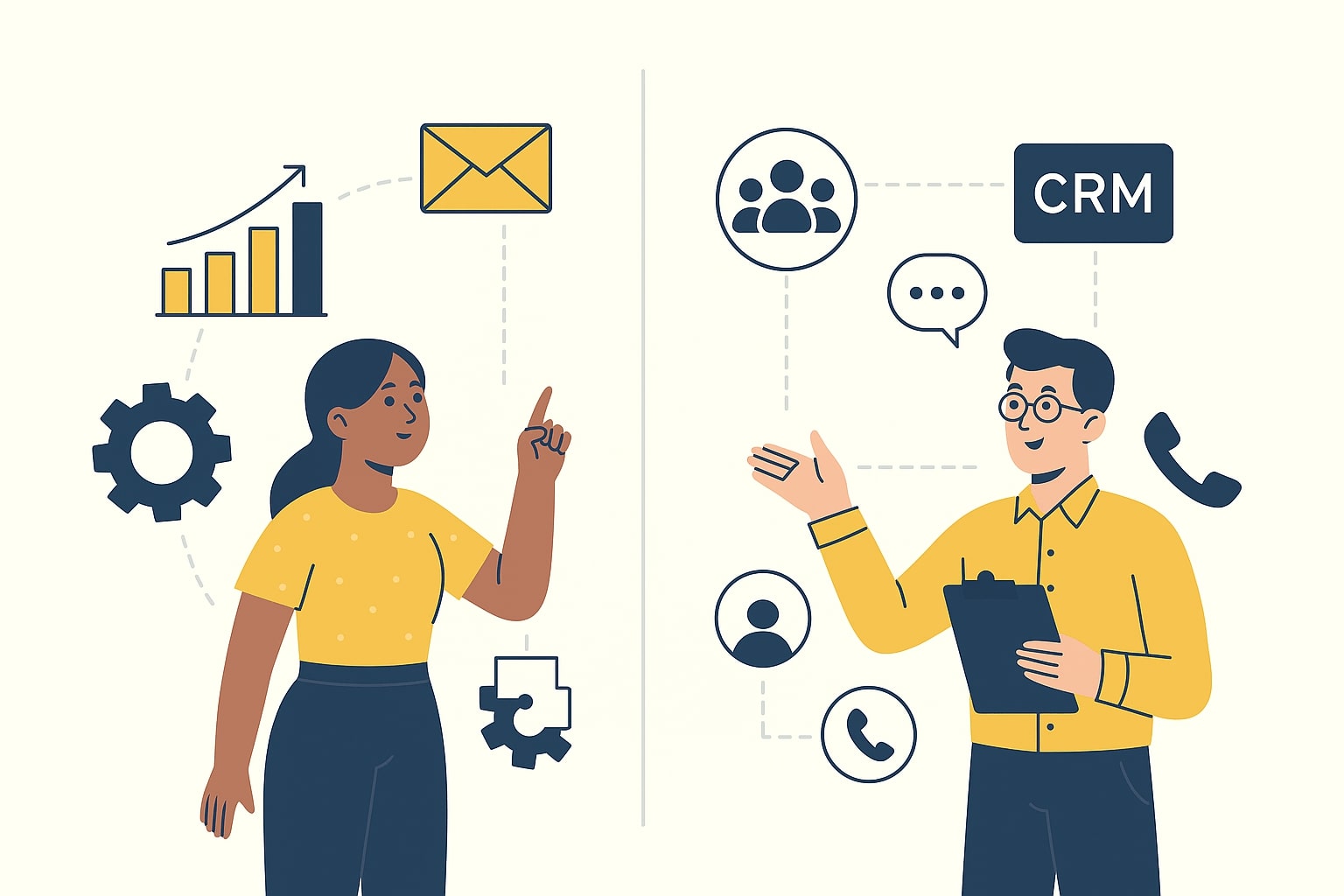Surely you’ve heard of the “for Dummies” books, right? They cover a wide range of topics; everything from the stock market and artificial intelligence to chess and football. Sure, the word is derogatory, but readers of the “for Dummies” books don’t seem to mind as long as it helps them understand the nuts and bolts of a subject. Any subject. But here’s a subject that will never earn that “dummy” label—marketing automation.
So, what is marketing automation?
Basically, marketing automation is a tool to achieve more, with less. More revenue, more customers, and more possibilities using fewer resources, time, and money. Simply put, marketing automation is a smart solution to complex challenges. According to leading research and advisory company Gartner, marketing automation software helps marketing professionals segment customers, manage related data, and launch effective, highly targeted campaigns with far greater efficiency.
That efficiency also comes in the form of processes that can be built and used by marketing professionals to create relevant content. And that “right” content can be delivered when and where it’s needed and be scaled to meet precise marketing needs.
With the definition of marketing automation behind us, let’s focus on the fun stuff—how marketing professionals use it to up their marketing game.
Why should you care about marketing automation?
Not to suggest that marketing automation is so efficient that it will clear your schedule of to-do’s and tactics, but it can enable you to free up time and resources to work on other pressing projects and initiatives.
Examples of doing more with marketing automation:
- More internal and external communications.
- More customer engagements.
- Faster response times when addressing new information or tackling unforeseen challenges.
- You can achieve higher relevance concerning a topic.
- Gain a deeper understanding of your customers, their business challenges, and goals.
Less is more:
- You will spend less time and money acting on, and completing tasks.
- You will spend less money for equal, often better, outcomes.
- You will reduce customer churn (remember, it costs far more to get a customer than to keep one).
- You can use fewer tools to achieve your marketing goals.
Do you care about … ?
In the end it’s about caring about something. Do you care about customers that are loyal to your brand? Do you care about improving customer satisfaction? Do you care about reaching higher lifetime values? Do you care about improving the conversion to sale ratio? And do you care about five-out-of-five stars, 100% rating or a thumbs up? In that case you care about marketing automation. Even if you don’t care about exactly HOW you can achieve more with less.
How you can achieve more with less
So you do care? Marketing automation is not a fixed set of tools you can deploy. Many automation products do one thing well, but are lacking in others. Your marketing strategy will evolve and change so your toolset should evolve with your strategy. If you make choices today you can run into issues later on if there’s no solid reasoning behind your decisions. This is a two-edged sword however. I’ve seen many promising projects fail because people are afraid to go live. It’s like the tale of the clock builder:
A clock builder was working on the greatest clock ever built. Every part of the clock was created out of the correct material, shaped just right with every part honed to perfection. If a new part was finished the clock builder decided the previous part did not live up to the same quality and he started over. He died before the clock was ever finished. He simply ran out of time because of his quest for perfection.
In most cases the journey is less ironic perhaps, I do want to stress the importance of forward momentum. In MarTech the abundance of options can be overwhelming. If the tools are actually making the process more difficult it’s time to change your methods. Contact me if you want to automate your marketing automation efficiently.
The four pillars of marketing automation
In order to build your automation workflow you will first have to lay a solid foundation. By using the four pillars listed below you can make decisions faster with a reliable outcome.
1. Save time
Many routine tasks can be automated. For instance mailings, auto-responders, and the collection of data points and structuring data. This will save time that marketing professionals can invest in optimizing current methods and develop new strategies or campaigns.
2. Save costs
A lot of time is spent on customer service which costs more than it creates in revenue. Although customer service is important, many interactions can easily be automated. Also, more efficient targeting can reduce the advertising budget and increase ROI.
3. Increase customer value
The traditional sales funnel has proven to be limited with little regard for returning AND retaining customers. Upselling, circular sales strategies, and nurturing of existing customers will increase revenue. A lot of these efforts can easily be automated.
4. Extend customer loyalty
Positive user experiences cause a spike in endorphins which leads to a sense of euphoria. This feeling is short lived however, negative user experiences linger much longer and will cause harm to your brand. By providing your customers with a series of positive interactions and limiting negative experiences you will extend the loyalty of your customers.
Importance of understanding the customer journey
In order to convert a lead to a customer the prospect will have to take a customer journey. This is regularly confused with a sales funnel however this is not correct. A funnel is a one-way path with a number of potential customers of which a lot will not reach the finish. A customer journey is a story with a beginning, a middle, and an end with various forks in the road and options to consider. Customer journeys are individualized experiences, few customers will travel the exact same path.
A nonlinear and forking journey is not a pleasant prospect for a marketing professional. They’re called leads for a reason, you’ll want to lead them to their destination, not let them wander. However, your (prospective) clients often don’t want to be instructed to the endpoint, they’d rather be guided along the way. By implementing various customer journeys the marketing department can switch tracks according to all available data of the lead or customer. This would be nearly impossible without marketing automation. Here are six customer journeys to get you started.
1. Acquisition
This is the journey that most resembles a standard sales funnel with the difference that the acquisition journey is aimed at the individual. You’re guiding a lead to a paying customer. The first step is often to trigger an action, for instance subscribing to a newsletter, download an ebook or enter a contact form. This will show you there’s an actual interest and the threshold for a monetary transaction is lowered.
By the way, if you want to know more about this subject feel free to contact me.
[calendly link]
Did it work? Wait a moment, I’ll check my inbox! Alright you’re a savvy person, let’s move on.
2. Welcome
Reducing customer churn is a very important part of building a stable and successful business. The first purchase is just the start of a new journey, with new opportunities. Let customers know they are appreciated, that they are not just a client but a brand ambassador and part of a community. Companies are built on the trust of customers, so show them you appreciate their patronage.
3. Cross-sell
Unless you sell one product with a life-time warranty you’ll probably want to implement a cross-selling journey. Did a customer open a bank account with a debit card? Maybe they’ll be interested in a credit card, mortgage or car insurance. Not only are you creating new sources of revenue from an existing customer, you are also making it easier for clients to purchase services and/or goods they need.
4. Upsell
There are two ways of upselling to existing customers. You can either sell more of the same product or sell better / improved versions of these products or services. This can be achieved by offering discounts for buying in bulk for example, or promoting the new iteration of a previously bought item. Buybacks while purchasing a new article is a common strategy in smartphone sales. Apart from creating new revenue you’re taking old products from the market so they won’t interfere with your sales strategy.
5. Retention
It’s common knowledge that retargeting or retaining existing customers costs less compared to acquiring new customers. This does vary depending on the business. Some companies focus so much on converting new customers they don’t notice the churn of customers abandoning the company. In business with a subscription model this is pretty easy to flag automatically, when it concerns goods this can be more difficult to notice but it’s definitely possible.
6. Winback
No matter what you do, some customers will cancel their subscription or stop purchasing your goods. After a cancellation, automate a response that you’re sorry to see them leave. Ask them why they’re leaving so you can improve retention in the future. You can also make them a new offer to sign up again. Be careful with this strategy though, some customers are not worth holding on to. You can also automate cost-to-gain ratio calculations.
How far can you push automated personalization?
If your emails start with “Dear customer” this customer is certainly not very dear to the company. If they are in the system you should address them with their name. This also invokes trust as many scam operations use exactly this general approach. “Dear A.” or “Mister B.” is also an automated response that can be easily fixed within the autoresponder system. Or perhaps not so easy because you know exactly the type of mail I’m referring to!
Another issue with a lot of automated responses is the amount of ‘broken’ elements. For instance an HTML mail that isn’t optimized for mobile, fixed width messages that are unreadable or images that are not available on the server. You don’t need to own a PC, laptop, netbook, tablet, and mobile phone for every operating system to check these issues if you use the right tools and manage your content correctly.
When managing the marketing of a webshop you should really consider connecting the CMS database of the webshop software with the marketing tools. This allows you to create campaigns based on the actual collection, not just the brand. Without insight the marketing team is riding blind which leads to campaigns with low CTR and ROI. A reliable CMS separates the interface from the data and database, connecting product information to the marketing tools should not be a large hurdle to overcome.
Go for incremental improvements
I could end this blog with a grand statement promising enormous gains quickly with a minimum of effort. But I’m pretty sure you’re not a dummy but a professional who understands that Rome wasn’t built in a day. By implementing incremental improvements to your current strategy and automating processes using advanced MarTech solutions you can improve business activities without running the risk of bringing the house down.
Let’s take the next (small) step together and contact me today.




